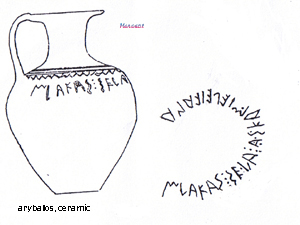Translation of short inscriptions.

Etruscan_Phrases
Translation of Short Inscriptions (continued)
Scripts, Pottery and Stele:PA, PB, PC, PD, PE, PG, PJ,
PK, PL, PM, PN, PO,
PP, PQ, PR, PS, PT, PU, PX, PY, PZ
For the latest update of these
translations see Translation of Etruscan Devotional Plates
III (PDF)
January 9, 2015 (Contains Scripts PO through PZ).
by
Mel Copeland
(from a work published in 1981)
| General note: We shall attempt to get better and, where appropriate, more complete images of the texts. The Etruscan artifacts that contain texts are scattered in private and museum collections around the world and are thus very difficult to locate. With the cooperation of curators and owners of the artifacts in supplying the desired images the understanding of Etruscan history will become more complete. It is the objective of this site to present accurate images with credits to the source of the images and the location / provenance of each artifact containing text. Until better images are received we must make do with what we have. | ||||||||||||||||||
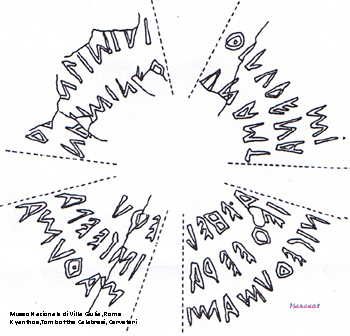 |
Script PA – Kyanthos
from the Tomb of the Calabresi, Cerveteri,
seventh century B.C., Museo di Villa Giulia,
Rome (Image: "L'etrusco dalla A alla 8,"
Biovanna Bagnasco Gianni). PA-1 MI NICE THUM ( To me (L. Dat. mihi) victory / Nike (L. Nike); then, at that time (L. tum) a friend (L. amicus-a; Fr. ami-e) Mathuma / Maduma? PA-6 AE _N LISIAI THIPO ( PA-10 IERE ERA ISTE EPA [Translation: yesterday (L. heri, or here; It. ieri; Fr. heir) the mistress (L. era-ae, f.) that of yours (L. iste, ista, istud) she spies, watches out for? (L. speculor-ari; it. spiare; Fr. épier) PA-15 NAMIN ER UNAS (VNAS) T..A? F8E (UBE, UVE) LERO (LERV) Translation: a wood, grove? (L. nemus-oris) or not even, neither (It. nemmanco, nemmeno) one ( (L. unnus-a-um, unius, uni, una; It. un, uno, una; Fr. Un, une; Welsh, un-au) you go to meet , go to (L. obeo-ire) god (Lar, laris, lares) or triumph, vicotry? (L. laurus-i) or the spectre, ghost larua-ae). |
|||||||||||||||||
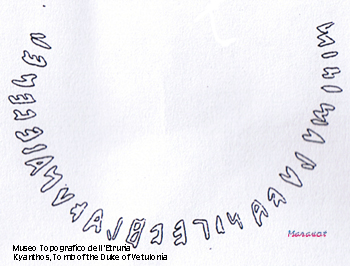 |
Script PB — Kyanthos
from the Tomb of the Duke of Vetulonia,
Museo Topographico dell'Etruria, Florence
(Image: "L'etrusco dalla A alla 8," Biovanna
Bagnasco Gianni). PB-1 MINIMU (MINIMV) LO FANI FANI) PEUV, PEUB (PEF8) [Translation: minimul, the least (L. minimus; It. minimo) of them, it (L. id, ille, illa, illud; It. lo) of the temples (L. fanum-i) of the youth (L. pubes-is) PB-5 LAKONAI (LAKVNAI) E FENE Le [Translation: Laocoon, a Trojan priest (L. laocoon-ontis) or Spartan (L. Laco, [Lacon]-onis) from, out of (L. e) you come (L. venio, venita, veni, ventum; It. venire) there (Fr. le, la)] |
|||||||||||||||||
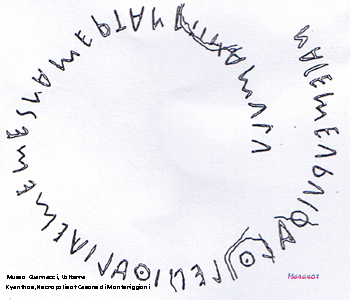 |
Script PC – Kyanthos
from Tomb BB6, Necropolis of Casone di
Monteriggioni, Museo Guarnacci, Volterra.
(Image: "L'etrusco dalla A alla 8," Biovanna
Bagnasco Gianni). PC-1 NATE or NAPE ME ORO (VRV) ITHAL (I |
|||||||||||||||||
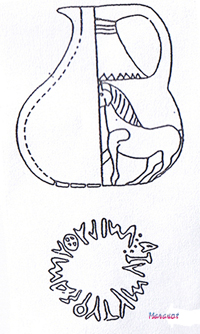 Script PD Script PD |
Script PD – Oniochoe. PD-1 MILO (MILV) THUMAS ( Note: In a Phrygian sherd we have MILAS, probably the plural of MILV. (See Phrygian1.html) Thus, "one thousand you tame warmed." |
|||||||||||||||||
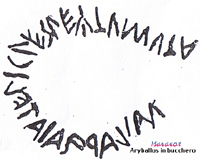 Script PG Script PG |
||||||||||||||||||
|
|
||||||||||||||||||
|
Script PG, Aryballos, bucchero (Image: "L'etrusco dalla A alla 8," Biovanna Bagnasco Gianni). PG-1 SI LARFAIA or
LARFAI ATELICLES
or TELICLES LEKTVM VTA [Translation:
if, supposing that (L. si; It. se, Fr.
si) the ghost, spectre (L. larva
(larua) -ae) of the Ateli Ateli, name,
(L. Attalus-i, adj. Attalicus-a-um,
name of several kings of Pergamum; or
Atelicles, or Telicles) chosen,
excellent (L. lectus-a-um) he is at
leisure (L. otior-ara) Thus:
"Supposing the ghost / spirit of
Atelicles the chosen he is at
leisure." Note: The "F" faces towards the word to which it belongs. Some Etruscan texts used this technique to separate words. The final "S" in Atelicles also faces the word to which it belongs. |
||||||||||||||||||
|
Script PE, Aryballos, ceramic (Image: "L'etrusco dalla A alla 8," Biovanna Bagnasco Gianni). PE-1 MvLAKAS:
SELA: ASKA MIELE IUAN (IFAN)
[Translation: you make gentle, soften
(L. mollesco-ere); the chair, seat (L.
sella-e; It. selle; Fr. selle, seller,
to saddle) of food (L. esca-ae) honey
(L. mel, mellis; It. miele) of
eternity, a lifetime (L. aevum-i;
aeus-i) or Euan, name of Bacchus] |
||||||||||||||||||
Script PQ, Tablet Museo
Civico, Viterbo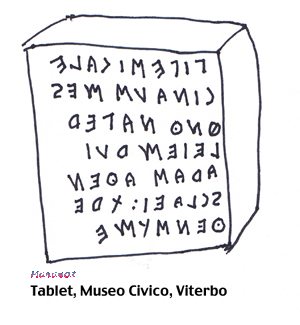 |
||||||||||||||||||
| Script PQ (right) Note: As can be discerned in looking at the tablet's two borders, there appears to be a missing section of the tablet adjoining the right-hand side. PQ-1 P IPE SI CALE [Translation: ...P ipe (unknown word; first word may be tipe, type, model); himself, herself, itself (L. se, sese; It. si; Fr. se) you call, summon (L. calo-are)] PQ-4 CINA VS MES [Translation: he burns, incinerates (L. incendo-cendere; It. incindiare; cynnau, Welsh) the bone (L. os, oris, mouth; os, ossis, bone; It. osso, bone; Fr. os, bone) you pass (L. meo, meare, to go, pass; 2nd pers. pres. mes)] PQ-7 PHvNTH (ØvN PQ-9 LEIEM RVI [Translation: lioamness (L. lea-ae and laena; 1st decl. Acc., le) of the king, regent (L. rex, regis; It. re; Fr. roi)] PQ-11 ARAS ATHENaS (A PQ-13 S CLAEI: TRE [Translation: ...S Cleo, the muse of history (L. Clio-us; possibly 5th Decl. gen.-ei; See ELINEI, Helen of Troy's name, and PHERSIPNEI, Gr. goddess Persephone) three (L. tres, tria; It. tre; Fr. trois; Toch., tri, traiy; Gr. tria; Welsh, tri, tair)] Note: The "S" ends a word on the missing tablet; Claei is undoubtedly a noun. Tre refers to the next line, because of the separating punctuation. PQ-16 THEN ( |
||||||||||||||||||
 Script
PK Script
PK |
||||||||||||||||||
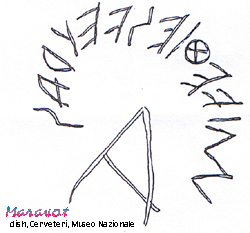 |
||||||||||||||||||
| Above: Script PJ,
ceramic dish, Cerveteri, Museo Nazionale
(Image: "L'etrusco dalla A alla 8," Biovanna
Bagnasco Gianni). PJ-1 A MI FEXIES FETRAS [Translation: To (L. a) my (L. meus, mihi) Vexies (name, plural; Re: L. vexillum-i, a standard, flag, a company, troop) young (L. fetura-ae, fetus-us; feturas, 1st Decl. Accus. pl.) Note: the "M" seems to be written backwards and is unusual. If FETRAS is plural, then Vexies must be plural and may be "troop." |
||||||||||||||||||
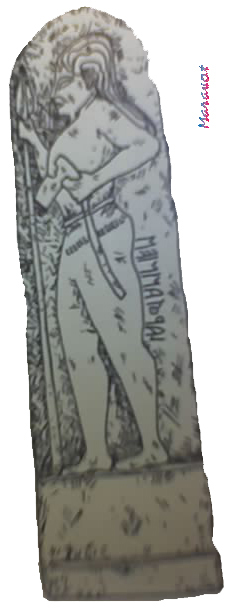
(Left): Script PL,
stele of "Aninies." |
Above: Script PK, Stele
known as "Avil Tite," which we title,
"Tities Oxiem." PK-1 MI AFILES TITEM OCHSIEM (V Note: The Etruscan peoples were organized in a Confederation of 12 cities, each perhaps being dominated by a tribe. Thus, if there were 12 tribes, this warrior may have beloged to the Eighth Tribe. |
|||||||||||||||||
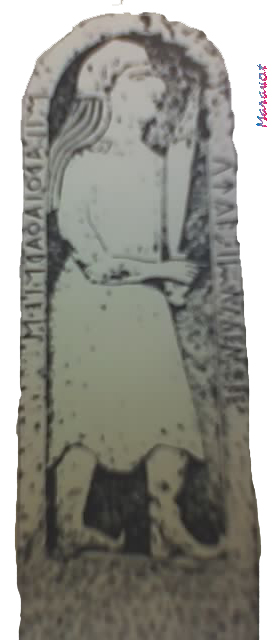 |
||||||||||||||||||
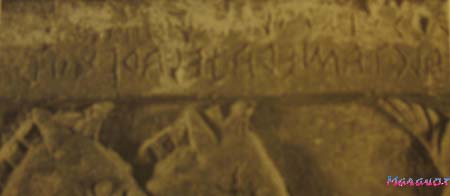 Script PN (Above) PN-1 ALC [Translation: someone (someone, something (L. aliquo, aliqua, aliqui..) PN-2 TAMERA [Translation: name, Tamera?] PN-3 TESARE ....[Translation: to weave, compose (L. texo-texere; It. tesere; Fr. tisser)] (rest unreadable) |
||||||||||||||||||
| (Above):
Script PM PM-1 MI LARTHIA (LAR PM-4 VCHVLEIM VIRI RIVS TIE? [Translation: eye (L. oculus-i; -im, Acc.?) of man (L. vir, viri) of the day (L. day (L. dies-ei, day; diu, by day; diutiuus, longer; Welsh, dydd; Scot, di). Note: This man appears to be an augur, since he is not armed. |
||||||||||||||||||
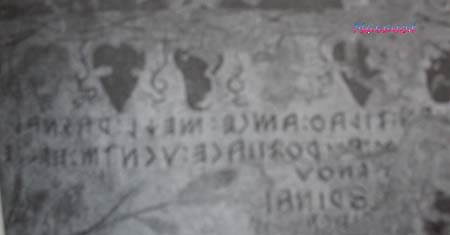 Script
PO, (Left) Tomba Scudi, Tarquinia Script
PO, (Left) Tomba Scudi, TarquiniaPO-1 _N: SILAR: AM CE: MECH (ME PO-9 ORO (VRV)? ROSTIA CE: VCNTM: HA CLE [Translation: I speak (L. oro-are) of Rostia, person's name (re: L. rosetum-i, a garden of roses) to us (It. ce) we / I sing? (L. occento-are, to sing a seranade to; we sing, occentamus; Conj. pres. 1st person, occentem) PO-13 UN RV (FNRV) [Translation: One (L. unnus-a-um, unius, uni, una; It. un) I bedew (L. roro-are) PO-14 BRINAI (8RINAI) [Translation: Brinai, name] |
||||||||||||||||||
—Θ
Launched 03.10.07
Upadated:
3.11.07; 4.15.07; 5.31.09; 6.02.09; 6.04.09;
1.12.15, 6.10.2022
Copyright
© 1981-2022 Maravot. All rights reserved.
Copyright © 1981-2022 Mel Copeland. All rights
reserved.
